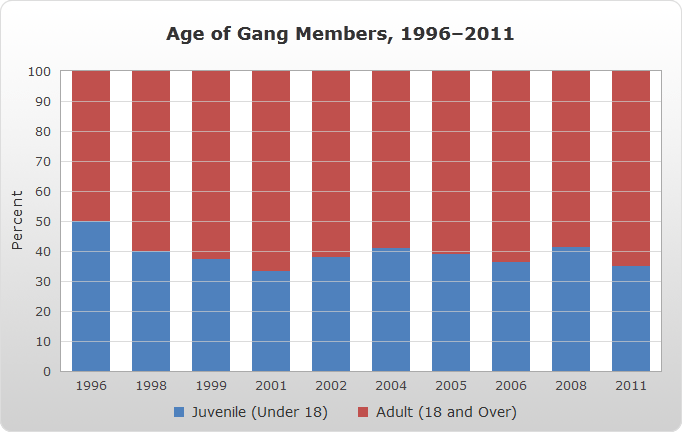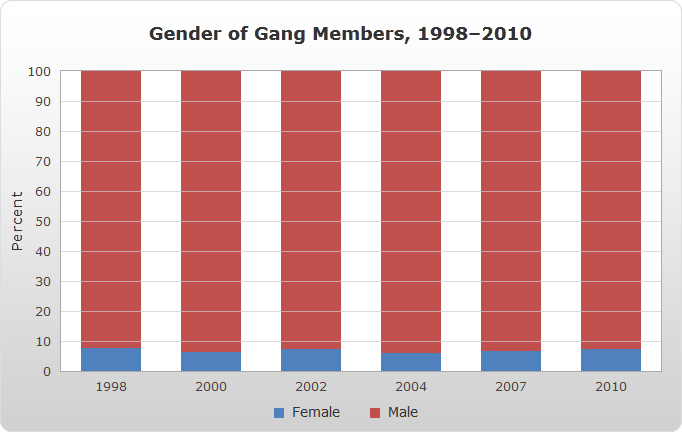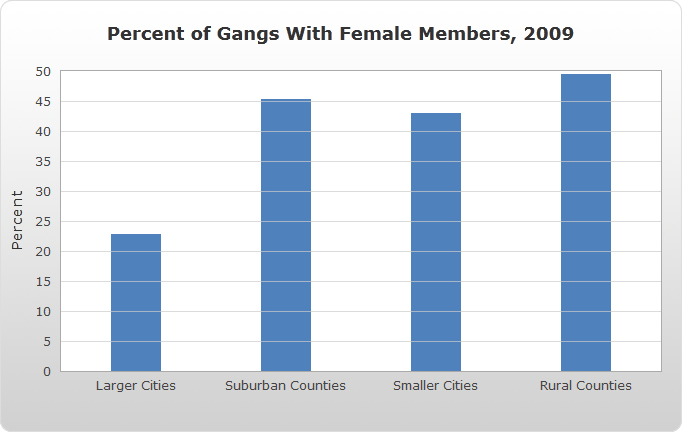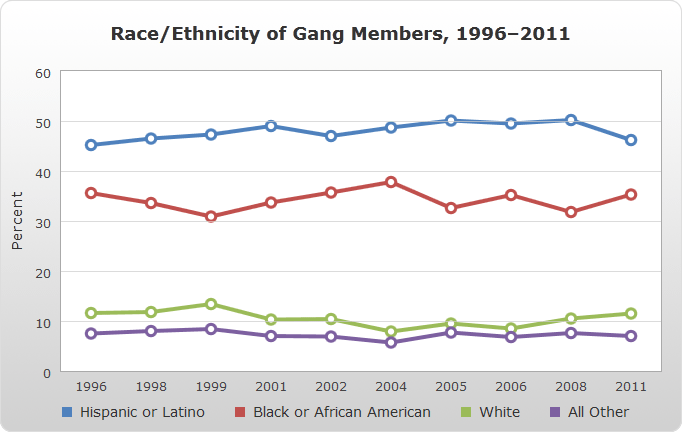Demographics
Age of Gang Members
Respondents provided information regarding the estimated ages of gang members in their jurisdictions.
- In virtually every survey year, law enforcement agencies report a greater percentage of adult (18 and over) gang members compared with juvenile (under 18) gang members.
- The most recent figures provided by law enforcement indicate that more than three out of every five gang members are adults.
Analysis for this section pertains only to law enforcement agencies reporting gang problems.
| Year | Juvenile (Under 18) | Adult (18 and Over) |
|---|---|---|
| 1996 | 50.0 | 50.0 |
| 1998 | 40.1 | 59.9 |
| 1999 | 37.3 | 62.7 |
| 2001 | 33.2 | 66.8 |
| 2002 | 38.0 | 61.9 |
| 2004 | 41.1 | 58.9 |
| 2005 | 38.9 | 61.1 |
| 2006 | 36.5 | 63.5 |
| 2008 | 41.4 | 58.6 |
| 2011 | 35.0 | 65.0 |
Age of Gang Members by Area Type
The age of gang members is compared across area types in 2011.
- Larger cities and suburban counties, which typically have long-standing gang problems, are more likely to report more adult gang members than juvenile gang members.
- Conversely, smaller cities and rural counties, whose gang problems are relatively more recent, are more likely to report equal proportions of juvenile and adult gang members.
| Juvenile (Under 18) | Adult (18 and Over) | |
|---|---|---|
| Larger Cities | 32.6 | 67.4 |
| Suburban Counties | 36.7 | 63.3 |
| Smaller Cities | 48.0 | 52.0 |
| Rural Counties | 58.9 | 41.1 |
Analysis for this section pertains only to law enforcement agencies reporting gang problems.
Gender of Gang Members
Respondents provided information regarding the gender of gang members in their jurisdictions.
- Law enforcement agencies overwhelmingly report a greater percentage of male gang members versus female gang members—a typical finding from law enforcement data, but one that is challenged by other research methodologies.
- Despite a growing concern of females joining gangs, little to no change in the percentage is observed across survey years.
| Female | Male | |
|---|---|---|
| 1998 | 7.7 | 92.3 |
| 2000 | 6.4 | 93.6 |
| 2002 | 7.3 | 92.8 |
| 2004 | 6.1 | 93.9 |
| 2007 | 6.6 | 93.4 |
| 2010 | 7.4 | 92.6 |
Analysis for this section pertains only to law enforcement agencies reporting gang problems.
Gangs With Female Members
Respondents provided information regarding gangs with female members in their jurisdictions.
- A large percentage of agencies (nearly one-quarter) could not provide information regarding the prevalence of female membership within gangs, suggesting that this issue is of secondary or lesser significance for law enforcement.
- Of those agencies that could provide information, proportionally few (less than 15 percent) reported that none of the gangs in their jurisdictions have female members.
- Nearly half of the gangs outside of the larger cities are reported to have female gang members, compared with approximately one in four in the larger cities. Of course, these results must be interpreted cautiously because of the sizeable amount of missing data.
| Percent | |
|---|---|
| Larger Cities | 22.8% |
| Suburban Counties | 45.3% |
| Smaller Cities | 43.0% |
| Rural Counties | 49.5% |
Analysis for this section pertains only to law enforcement agencies reporting gang problems. Please see the Prevalence of Gang Problems section.
Race/Ethnicity of Gang Members
Respondents provided information regarding the race/ethnicity of gang members in their jurisdictions.
- Law enforcement agencies report a greater percentage of Hispanic/Latino and African-American/black gang members compared with other race/ethnicities.
- The most recent figures provided by law enforcement are 46 percent Hispanic/Latino gang members, 35 percent African-American/black gang members, more than 11 percent white gang members, and 7 percent other race/ethnicity of gang members.
Analysis for this section pertains only to law enforcement agencies reporting gang problems.
| Year | Hispanic or Latino | Black or African American | White | All Other |
|---|---|---|---|---|
| 1996 | 45.2 | 35.6 | 11.6 | 7.5 |
| 1998 | 46.5 | 33.6 | 11.8 | 8.0 |
| 1999 | 47.3 | 30.9 | 13.4 | 8.4 |
| 2001 | 49.0 | 33.7 | 10.3 | 7.0 |
| 2002 | 47.0 | 35.7 | 10.4 | 6.9 |
| 2004 | 48.7 | 37.8 | 7.9 | 5.7 |
| 2005 | 50.1 | 32.6 | 9.5 | 7.7 |
| 2006 | 49.5 | 35.2 | 8.5 | 6.8 |
| 2008 | 50.2 | 31.8 | 10.5 | 7.6 |
| 2011 | 46.2 | 35.3 | 11.5 | 7.0 |
Race/Ethnicity of Gang Members by Area Type
The race/ethnicity of gang members is compared by area type.
- Across all area types, the majority of law enforcement agencies report that African-American/black and/or Hispanic/Latino individuals predominate among documented gang members.
- Prevalence rates of white gang membership are lowest in larger areas but significantly higher in smaller areas, where the rate is more than 1.5 times as high.
| Larger Cities | Suburban Counties | Smaller Cities | Rural Counties | |
|---|---|---|---|---|
| Black or African American | 39.0% | 32.7% | 20.3% | 56.8% |
| Hispanic or Latino | 45.5 | 51.0 | 53.8 | 24.8 |
| White | 9.7 | 9.1 | 14.6 | 14.9 |
| Other | 5.8 | 7.2 | 11.3 | 3.4 |
Analysis for this section pertains only to law enforcement agencies reporting gang problems. Please see the Prevalence of Gang Problems section.
« PreviousTable of Contents Next »
Suggested citation: National Gang Center. National Youth Gang Survey Analysis. Retrieved [date] from https://nationalgangcenter.ojp.gov/survey-analysis.






